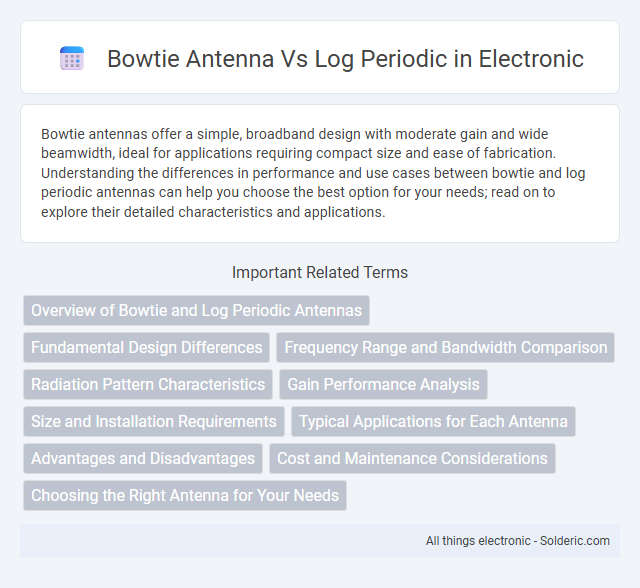Bowtie antennas offer a simple, broadband design with moderate gain and wide beamwidth, ideal for applications requiring compact size and ease of fabrication. Understanding the differences in performance and use cases between bowtie and log periodic antennas can help you choose the best option for your needs; read on to explore their detailed characteristics and applications.
Comparison Table
| Feature | Bowtie Antenna | Log Periodic Antenna |
|---|---|---|
| Design | Planar, triangular elements forming a bowtie shape | Multiple dipole elements arranged logarithmically |
| Frequency Range | Broadband, typically 0.5 to 3 GHz | Ultra-wideband, from VHF to UHF (30 MHz to 3 GHz+) |
| Gain | Moderate gain (around 5-7 dBi) | Higher gain (6-10 dBi depending on elements) |
| Polarization | Linear, typically horizontal or vertical | Linear polarization, adjustable by element alignment |
| Radiation Pattern | Wide beamwidth, directional | Directional with narrower beamwidth |
| Impedance | Typically 75 ohms, can be matched to 50 ohms | Impedance varies but designed for ~50 ohms |
| Applications | TV reception, UWB communication, RFID | Wideband communication, scanning receivers, EMC testing |
| Complexity | Simple, easy to fabricate | Complex due to multiple elements |
| Size | Compact, planar | Larger due to multiple dipole elements |
Overview of Bowtie and Log Periodic Antennas
Bowtie antennas feature a simple, planar design with wideband capabilities for frequencies ranging from VHF to UHF, making them ideal for applications requiring broad frequency coverage and compact size. Log periodic antennas consist of a series of dipole elements with progressively increasing lengths and spacings, providing consistent impedance and gain across a wide frequency range, typically from HF to microwave bands. Both antennas serve wideband functions, but bowtie antennas emphasize compact, planar forms, while log periodic antennas offer predictable gain patterns and higher directional control.
Fundamental Design Differences
The bowtie antenna features a simple, planar design with two triangular conductive elements forming a wideband dipole, optimized for broadband frequency response and compact size. In contrast, the log periodic antenna consists of a series of progressively sized elements arranged in a tapered linear pattern, enabling directional gain and consistent impedance across a wide frequency range. While bowtie antennas emphasize omnidirectional radiation patterns and structural simplicity, log periodic antennas prioritize multi-element phase coherence for enhanced directivity and gain performance.
Frequency Range and Bandwidth Comparison
Bowtie antennas typically offer a wide bandwidth, covering frequencies from approximately 300 MHz to 3 GHz, making them ideal for broadband applications such as television and Wi-Fi signals. Log periodic antennas provide an even broader frequency range, often extending from 100 MHz up to 3 GHz or higher, due to their design of multiple elements scaled logarithmically. The bandwidth of log periodic antennas is generally superior, featuring consistent gain and impedance over their entire operating frequency range, whereas bowtie antennas have high gain but slightly narrower effective bandwidth.
Radiation Pattern Characteristics
Bowtie antennas exhibit a broad, nearly omnidirectional radiation pattern ideal for wide-angle signal reception, while log periodic antennas provide a directional radiation pattern with high gain and consistent performance across a wide frequency range. The bowtie's broad beamwidth makes it suitable for applications requiring extensive coverage, whereas your choice of a log periodic antenna enhances signal strength in a specific direction, improving long-distance communication. Understanding these radiation pattern characteristics helps optimize antenna selection based on your coverage and gain requirements.
Gain Performance Analysis
Bowtie antennas exhibit moderate gain with a wide bandwidth, making them suitable for applications requiring broad frequency coverage but less directional focus. Log periodic antennas deliver higher gain and more consistent performance across a wide frequency range due to their self-similar structure, providing enhanced signal strength and directivity. Analyzing gain performance, your choice depends on the balance between broader frequency adaptability (bowtie) and stronger, more focused signal reception (log periodic).
Size and Installation Requirements
Bowtie antennas are typically more compact and lightweight, making them easier to install in limited spaces or on smaller structures. In contrast, log periodic antennas require a larger installation area due to their extended element design, which can complicate mounting and alignment. Your choice depends on available space and installation complexity, with bowtie antennas offering a more streamlined setup in constrained environments.
Typical Applications for Each Antenna
Bowtie antennas are commonly used in TV broadcasting and wireless communication due to their wide bandwidth and simple design, ideal for receiving UHF and VHF signals. Log periodic antennas excel in applications requiring consistent directional gain across a broad frequency range, such as spectrum monitoring and antenna measurement systems. Your choice depends on whether you prioritize broadband reception with moderate directionality or a more focused gain over multiple frequencies.
Advantages and Disadvantages
Bowtie antennas offer a wide bandwidth and simple design, making them ideal for broadband applications and easy fabrication. However, they have lower gain compared to log periodic antennas, which provide high gain and directional characteristics, suitable for focused signal reception and transmission. Log periodic antennas are more complex and larger in size, potentially increasing cost and installation challenges.
Cost and Maintenance Considerations
Bowtie antennas typically incur lower initial costs and require minimal maintenance due to their simpler design and fewer components. Log periodic antennas demand higher investment and more regular upkeep to preserve performance because of their complex structure and multiple elements. Your choice may depend on balancing budget constraints with long-term maintenance commitments.
Choosing the Right Antenna for Your Needs
Bowtie antennas excel in providing wideband performance with simple design and compact size, making them ideal for applications requiring broad frequency coverage in limited space. Log periodic antennas offer superior gain and directivity across a wide frequency range, suitable for scenarios demanding long-distance reception and precise signal targeting. Selecting the right antenna depends on balancing factors such as frequency range, gain requirements, installation constraints, and intended use cases to optimize performance.
bowtie antenna vs log periodic Infographic

 solderic.com
solderic.com